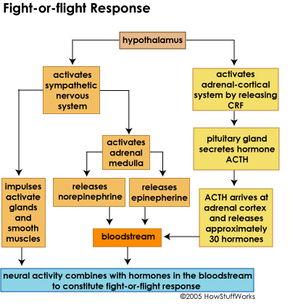Fight or Flight
To produce the fight-or-flight response, the hypothalamus activates two systems: the sympathetic nervous system and the adrenal-cortical system. The sympathetic nervous system uses nerve pathways to initiate reactions in the body, and the adrenal-cortical system uses the bloodstream. The combined effects of these two systems are the fight-or-flight response.
When the hypothalamus tells the sympathetic nervous system to kick into gear, the overall effect is that the body speeds up, tenses up and becomes generally very alert. If there's a burglar at the door, you're going to have to take action -- and fast. The sympathetic nervous system sends out impulses to glands and smooth muscles and tells the adrenal medulla to release epinephrine (adrenaline) and norepinephrine (noradrenaline) into the bloodstream. These "stress hormones" cause several changes in the body, including an increase in heart rate and blood pressure.
Advertisement
At the same time, the hypothalamus releases corticotropin-releasing factor (CRF) into the pituitary gland, activating the adrenal-cortical system. The pituitary gland (a major endocrine gland) secretes the hormone ACTH (adrenocorticotropic hormone). ACTH moves through the bloodstream and ultimately arrives at the adrenal cortex, where it activates the release of approximately 30 different hormones that get the body prepared to deal with a threat.
The sudden flood of epinephrine, norepinephrine and dozens of other hormones causes changes in the body that include:
- heart rate and blood pressure increase
- pupils dilate to take in as much light as possible
- veins in skin constrict to send more blood to major muscle groups (responsible for the "chill" sometimes associated with fear -- less blood in the skin to keep it warm)
- blood-glucose level increases
- muscles tense up, energized by adrenaline and glucose (responsible for goose bumps -- when tiny muscles attached to each hair on surface of skin tense up, the hairs are forced upright, pulling skin with them)
- smooth muscle relaxes in order to allow more oxygen into the lungs
- nonessential systems (like digestion and immune system) shut down to allow more energy for emergency functions
- trouble focusing on small tasks (brain is directed to focus only on big picture in order to determine where threat is coming from)
All of these physical responses are intended to help you survive a dangerous situation by preparing you to either run for your life or fight for your life (thus the term "fight or flight"). Fear -- and the fight-or-flight response in particular -- is an instinct that every animal possesses.
